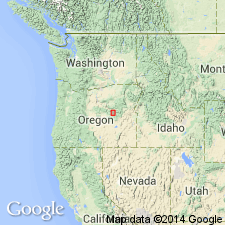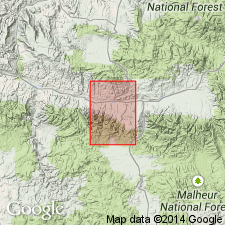
- Usage in publication:
-
- Cinnabar Tuff Tongue*
- Modifications:
-
- [Overview]
- AAPG geologic province:
-
- Blue Mountains province
Summary:
Pg. A25, A29 (fig. 4). Cinnabar Tuff Tongue of Fields Creek Formation (Brown and Thayer, 1966, USGS GQ-548). Is a massive to obscurely bedded waterlaid andesitic tuff rich in pumiceous fragments. Ranges from flint-textured bluish-gray to coarse-grained dusky-brown. Tuff is now mainly a quartz-albite-chlorite rock spotted with authigenic prehnite (Brown and Thayer, 1963, Jour. Sed. Petrol., v. 33, no. 2, p. 411-425). At Cinnabar Mountain, makes up most of upper part of formation; thickness about 3,500 feet. Thickens northeastward to about 8,500 feet and thins abruptly southeastward; locally, grades upward into siliceous mudstone, shale, and graywacke. Fields Creek Formation is believed to be no older than late Late Triassic age; fossil brachiopod HALORELLA recovered from transported blocks of reef limestone in basal shaly part of formation, near Horseshoe Butte (N.J. Silberling, written commun., 1963). [No fossils are reported from overlying Laycock Graywacke.] Age is considered Late Triassic(?).
[Misprint: GNU staff (USGS DDS-6; Menlo GNULEX) interpreted age of Cinnabar to be Late Triassic, based on Silberling's findings, and stated that the age of the Cinnabar had changed. The authors of this report are very clear about the uncertainty of the age of the rocks and assign the Fields Creek and Cinnabar to Late Triassic(?) (see p. A29, fig. 4), as they did in USGS I-447 and GQ-548. Only the Vester Formation and Keller Creek Shale are given definitive ages.]
Source: Publication.

- Usage in publication:
-
- Cinnabar Tuff* Tongue*
- Modifications:
-
- Named
- Dominant lithology:
-
- Tuff
- Pumice
- AAPG geologic province:
-
- Blue Mountains province
Summary:
Named for outcrops on Cinnabar Mountain as unit in Fields Creek Formation of Aldrich Mountains Group. [no type designated] Consists of water-laid andesitic massive tuff. Ranges from flinty bluish-gray to coarse-grained dark-olive colored pumice fragments. Flinty tuff weathers to distinctive cinnamon brown. Tuff is quartz, albite, chlorite rock spotted with authigenic prehnite. Is 8,500 ft thick in canyon of Riley Creek. Interfingers with Laycocke Graywackes on northeast slopes of First and Second Peaks of Aldrich Mountains, Mount Vernon 15' quad, Grant Co, OR. Unconformably underlies Rattlesnake Formation. Is assigned Late Triassic(?) age.
Source: GNU records (USGS DDS-6; Menlo GNULEX).
For more information, please contact Nancy Stamm, Geologic Names Committee Secretary.
Asterisk (*) indicates published by U.S. Geological Survey authors.
"No current usage" (†) implies that a name has been abandoned or has fallen into disuse. Former usage and, if known, replacement name given in parentheses ( ).
Slash (/) indicates name conflicts with nomenclatural guidelines (CSN, 1933; ACSN, 1961, 1970; NACSN, 1983, 2005, 2021). May be explained within brackets ([ ]).

